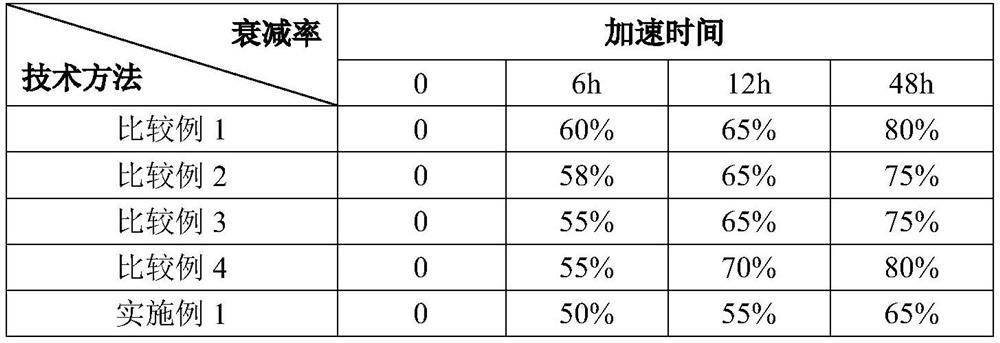Preparation method of peanut oil and peanut oil
A technology for peanut oil and peanuts, which is applied in the production of fat, edible oil/fat, fat oil/fat, etc., can solve the problems of not being able to be said to be sufficient, and the oxidation resistance and stability cannot be both, and achieve shelf life extension and flavor stability. Good, flavorful effect
- Summary
- Abstract
- Description
- Claims
- Application Information
AI Technical Summary
Problems solved by technology
Method used
Image
Examples
Embodiment approach
[0118] Typical embodiments of the invention include the following:
[0119] The enzymatic hydrolysis (peanut powder) and water were mixed according to the proportion disclosed below, and the protease, glycozyme, amylase, and pectin enzyme were added under suitable conditions, and the appropriate amount of reducing sugar was added. The resulting enzymatic slurry was collected into the heat treatment of the peanut (peanut crush) to replace the tap water added in conventional process production. Further, the oil-proof material after the heat treatment, the oil process such as the oil, and the flavor is rich and stable, and the oxidation stability is good.
[0120] in particular:
[0121] 1) Mix the enzymatic hydrolyzate (peanut powder) and water in the proportion of the set ratio, add protease, glycosidase, amylase and pectin enzyme, and add an appropriate amount of reductant sugar to react, collect the enzyme obtained after the reaction Episocolite;
[0122] 2) Add the enzyme epigri...
Embodiment 1
[0148] The self-made peanut powder (150 kg, partially degreasing) and water are mixed according to the weight ratio of 1: 3, and 3% by weight of protease, 1% by weight of glycosidase, 1% by weight of amylase and 1% by weight are added to the weight of peanut powder. The pectin enzyme was enzymatic, and 2% glucose was added to the reaction, and the enzymatic epigrotal pulp obtained after the reaction was collected.
[0149] In the heating pan, the flow rate (peanut crush) was added at a rate of 7t / h, and an enzymatic epigrotal pulp with respect to the weight of the peanut material was added to the inlet of the heating pan according to the flow rate of 80 kg / h, and the water vapor heating treatment was performed. 20 min, the material after heating the water was used to use a microwave (900 W) to perform a fry until moisture reached 6%, and then the press temperature was pressed at 50 ° C to obtain peanut oil. The resulting peanut oil added peanut oil for 0.2% by weight of water,...
Embodiment 2~5
[0184] In addition to adjusting the concentration of the enzymatic antimodese of the heating apparatus added during the heat treatment, and other conditions are the same as in Example 1 other than heating in the heat treatment (900 W, 10min).
[0185] Table 6 shows the effect of enzymatic hydrolysis plasma concentration (metering the mass ratio of peanut powder and water in the enzymatic solution) on peanut oil flavor.
[0186] Table 6
[0187]
[0188] It can be seen from Table 6 that the enzymatic anthrard plasma concentration is 1: 1 to 1: 8 to obtain peanut oils with rich flavor content. It is preferably 1: 2 to 1: 4. The enzymatic anthracemus concentration is preferably 1: 3, the peanut flavor is the best. This may be due to the perarotrosis of the concentration of 1: 4, the introduction of water, dilute the flavor of the peanut oil. The concentration 1: 2 is due to the tendency of the texture, which leads to a tendency to reduce the flavor of peanut oil.
PUM
| Property | Measurement | Unit |
|---|---|---|
| particle size | aaaaa | aaaaa |
| length | aaaaa | aaaaa |
Abstract
Description
Claims
Application Information
 Login to View More
Login to View More - R&D
- Intellectual Property
- Life Sciences
- Materials
- Tech Scout
- Unparalleled Data Quality
- Higher Quality Content
- 60% Fewer Hallucinations
Browse by: Latest US Patents, China's latest patents, Technical Efficacy Thesaurus, Application Domain, Technology Topic, Popular Technical Reports.
© 2025 PatSnap. All rights reserved.Legal|Privacy policy|Modern Slavery Act Transparency Statement|Sitemap|About US| Contact US: help@patsnap.com



